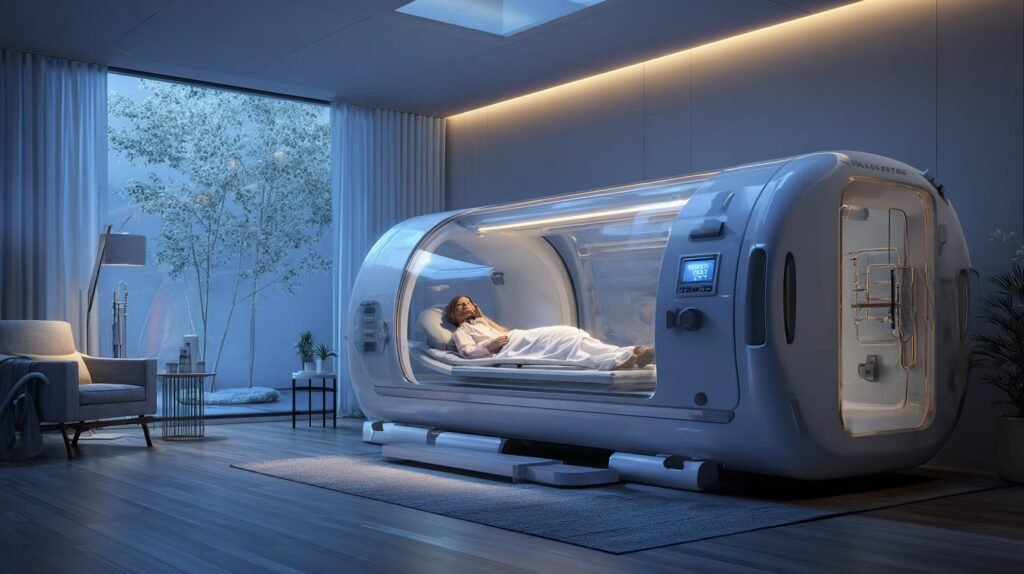Hyperbaric Oxygen Therapy (HBOT) has long been used to treat conditions like decompression sickness, chronic wounds, and carbon monoxide poisoning.
But over the past two decades, its potential applications have expanded into areas that continue to spark both hope and debate. One such frontier? Autism Spectrum Disorder (ASD).
From anecdotal accounts of improved communication to scientific studies examining cellular changes, the connection between HBOT and autism is attracting serious attention from parents, researchers, and advocacy groups alike.
In this post, we explore where the science stands, share real stories from families, and consider what’s ahead for this controversial yet promising therapy.
What Is Hyperbaric Oxygen Therapy (HBOT)?
HBOT involves breathing 100% oxygen in a pressurized chamber—typically at 1.3 to 2.0 times normal atmospheric pressure.
This pressurization allows the lungs to absorb more oxygen, which is then circulated throughout the body, promoting healing, reducing inflammation, and stimulating the release of growth factors and stem cells.
When it comes to autism, the hypothesis is that this oxygen saturation could reduce neuroinflammation and oxidative stress—both of which are often elevated in individuals with ASD.
What Science Says About HBOT and Autism?
While HBOT is not FDA-approved specifically for treating autism, several studies have attempted to evaluate its effectiveness.
-
Early Research
One of the earliest studies that made headlines was conducted by Dr. Dan Rossignol in 2009. Published in BMC Pediatrics, the randomized, double-blind controlled trial found that children receiving HBOT at 1.3 ATA with 24% oxygen showed significant improvements in overall functioning, receptive language, social interaction, and eye contact compared to those in the control group.
-
Neuroinflammation and Oxidative Stress in ASD
Multiple studies confirm that individuals with autism often experience higher levels of neuroinflammation and oxidative stress—biological imbalances that HBOT is known to help regulate.
A 2015 review in Frontiers in Neuroscience suggested that these two conditions could play a role in the development and severity of autism symptoms, and therapies aimed at reducing them may be beneficial.
Neuroinflammation and ASD – Frontiers
In a separate pilot study, 18 children aged 3–16 underwent 40 sessions of HBOT (1.3 atm with 24% O₂ or 1.5 atm with 100% O₂). While oxidative stress markers didn’t change significantly across the board, C-reactive protein (inflammation marker) levels dropped meaningfully, especially in children with higher baseline inflammation. Parents also reported significant gains in motivation, speech clarity, and cognitive awareness
A recent meta-analysis of 17 studies (totaling 890 children and adolescents) summarized outcomes: HBOT significantly reduced core autism symptoms (effect size –0.66) and boosted communication (–0.88), cognitive awareness (–0.93), and behavior (–0.80).
Though the authors noted variability in study quality, the overall signal supported modest improvements.
Real Stories: Hope in the Pressure Chamber
It’s not just the data that tells a story. Families across the world have shared personal testimonies of how HBOT has positively impacted their children with autism.
Take the story of Shannon Kenitz, whose daughter Grace—diagnosed with a rare mitochondrial disorder and autism—began speaking for the first time after a series of HBOT sessions.
Shannon later co-founded the International Hyperbarics Association (IHA) to support research and access to hyperbaric care.
Insights from Parents and Practitioners
Alongside clinical data, parent testimonials, and case series add a human dimension.
Some families describe improvements in social engagement, mood stabilization, and eye contact after HBOT courses.
In one retrospective descriptive study covering 30 children and one adult, parents consistently noted positive changes in behavior and daily interaction following sessions at 1.5–2.0 atmospheres with 100% oxygen.
These first-hand accounts provide context to the numbers—especially for parents who see small behavioral shifts add up to a better quality of life.
What’s Next? New Frontiers and Ongoing Trials
Researchers are now looking at multi-modal treatment approaches, where HBOT is combined with therapies like stem cell therapy or nutritional protocols to enhance its impact.
The upcoming Hyperbaric Medicine Conference by the International Hyperbarics Association (IHA) offers an excellent platform for parents, professionals, and researchers to explore these innovations. Attendees will learn about the latest findings, clinical experiences, and regulatory updates.
Save the Date: September 25–28, 2025
Location: Hilton Hotel, Pensacola Beach, Florida
More Info
Final Thoughts
Hyperbaric Oxygen Therapy for autism isn’t a miracle solution—but it may be a valuable piece of a much larger puzzle. Whether you’re a parent seeking options or a practitioner following the science, HBOT represents a frontier still worth exploring.
As always, consult your pediatrician or autism specialist before beginning any new therapy.
FAQs
Q1. Is HBOT FDA-approved for autism?
No. HBOT is not FDA-approved for autism, though it is approved for other medical conditions.
Q2. Are there risks involved in hyperbaric therapy?
When supervised professionally, HBOT is generally safe. Mild side effects can include pressure in the ears or temporary fatigue.
Q3. How many sessions are typically required?
Many parents report changes after 20–40 sessions, but the ideal number can vary based on individual needs.
Q4. Can HBOT replace behavioral therapies for autism?
No. HBOT should be viewed as a complementary therapy, not a replacement for behavioral or educational interventions.
Q5. Where can I learn more?
Visit the International Hyperbarics Association’s page on Autism and attend the upcoming Hyperbaric Medicine Conference for deeper insights.





